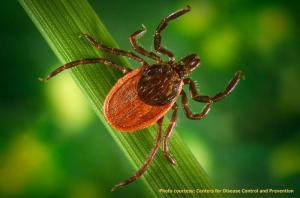It's Time for Tick Prevention
- posted: May 06, 2018
 Protect Your Pet Against Ticks
Protect Your Pet Against Ticks
Warm weather has finally arrived in York! But, it’s not all good. The coming of our long awaited spring brings not only sunny days and flowering plants, but also bugs, including ticks. Ticks are a nuisance to people and animals alike, and, they can carry disease. What can you do to protect your cat or dog from ticks and from illnesses such as Lyme disease?
First, check your pet (and yourself!) daily and remove any ticks you find, especially after a walk in the woods or parks. No tick preventative is 100% effective, and, if there are enough ticks present, they will get on your pet. Try to avoid touching ticks with your bare fingers—use a tissue, gauze or tweezers to grasp the tick near its head and firmly pull it off. If the head did not come out, no worries: It will eventually fall off and it causes more damage and pain to try to dig it out.
Second, use a good quality flea and tick preventative. For cats, choices are somewhat limited, but Patton carries Feline Bravecto which is a topical product applied to the skin every three months. It offers safe, long-lasting protection against both fleas and ticks. Products containing fipronil also provide some protection against ticks but have not been as effective for flea control as in years past, so keep this in mind if fleas are a concern.
For dogs, more choices exist to keep ticks away. There are almost too many to mention, so I will discuss the three products we have at Patton. A chewable version of Bravecto works great for killing fleas and ticks for three months at a time. There is also a monthly chewable called Simparica which is equally effective and budget friendly. The monthly topical Vectra 3D not only kills fleas and ticks, but also has a repelling effect that can last for several weeks and helps prevent creepy crawlers from jumping on your pet in the first place.
For any product, dog or cat, make sure to read application and handling instructions and never EVER apply a product meant for dogs to your cat as some are quite toxic to kitties. Always read labels carefully, and ask your vet about any concerns. All of the products mentioned are quite safe, but there are some medical conditions and circumstances in which certain products are not recommended.
Finally, consider vaccinating your dog against Lyme disease. Pennsylvania surpasses Connecticut in number of cases of Lyme disease per year. You can almost eliminate the chance of your dog getting Lyme with this trifecta: vaccinating, using a good tick preventative year round AND doing daily tick checks. Lyme does not always cause dogs to become ill, but some do experience fever, sore joints, lethargy and, in rare cases, a severe form of kidney disease which can be fatal. Ticks also carry Ehrlichia and Anaplasmosis which may cause illness in some dogs.
There is no vaccine for cats, and only isolated cases of Lyme have been found in cats with immune compromise, but cats can get other tick-borne illnesses. All the more reason to keep your cat protected with preventatives and to test and vaccinate for illnesses like feline leukemia and feline AIDS (FIV).
Talk to your vet about the best products to prevent ticks and whether your pet is a candidate for vaccination against Lyme. While we can’t put your pet in a bubble, we can do a lot to protect him against ticks and tick-borne diseases!
This blog brought to you by the Patton Veterinary Hospital serving Red Lion, York and the surrounding communities.
Location
Patton Veterinary Hospital
425 E Broadway
Red Lion, PA 17356
